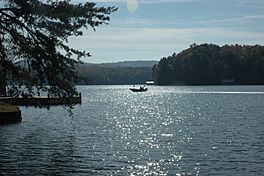Lake Burton (Georgia) facts for kids
Quick facts for kids Lake Burton |
|
|---|---|
 |
|
| Lua error in Module:Location_map at line 420: attempt to index field 'wikibase' (a nil value). | |
| Location | Rabun County, Georgia |
| Type | Reservoir |
| Primary inflows | Tallulah River |
| Primary outflows | Tallulah River |
| Basin countries | United States |
| Surface area | 2,775 acres (1,123 ha) |
| Max. depth | 120 ft (36 m) |
Lake Burton is a large reservoir in the northeastern part of Georgia. It covers about 2,775 acres (11.23 square kilometers) and has 62 miles (100 kilometers) of shoreline. You can find it in Rabun County, Georgia.
The lake is known for its super clear water. It's surrounded by the amazing Blue Ridge Mountains, which have lots of different plants and animals. Lake Burton turned 100 years old in 2020! Even though a company called Georgia Power owns and manages the lake, it's open for everyone to enjoy.
Contents
Building Lake Burton
Lake Burton was built in a deep valley along the Tallulah River. The river flows for about 10 miles (16 kilometers) through this area. The dam that created the lake was finished on December 22, 1919. The lake was completely full by August 18, 1920.
The dam is a strong concrete structure. It stands about 128 feet (39 meters) tall and stretches 1,100 feet (335 meters) across. It has eight special gates to control the water flow. Lake Burton is the highest lake in Georgia that Georgia Power manages.
The Old Town of Burton
Before the lake was built, the Cherokee Indians lived in the Upper Tallulah Valley. Later, settlers moved in, especially after gold was found nearby in 1828.
The lake gets its name from a town called Burton, Georgia. This town was once the second largest in Rabun County. It had about 200 people. Today, the old town of Burton lies completely underwater! The town was named after a local leader, Jeremiah Burton. People say that when the dam was closed, the water rose so fast that parts of the town couldn't be fully removed. For example, the steeple of the Baptist Church floated in the lake for three years before it finally sank. Now, only a few old cemeteries remain.
Powering Georgia
In the early 1900s, people started using hydroelectric power. This means making electricity from flowing water. The Tallulah River was perfect for this because it drops a lot in height.
Between 1914 and 1927, six dams were built along 28 miles of the river. Lake Burton is the biggest and highest of these lakes. It was designed to hold most of the water needed to power the turbines downstream. This project was one of the first big hydroelectric systems in North America. The electricity it made helped Atlanta grow into the big city it is today.
Life Around the Lake
For a long time, Lake Burton was pretty quiet because it was hard to reach. The Great Depression and World War II also slowed things down. Most of the lake wasn't even reachable by car until the 1960s! It was a hidden gem for fishermen, nature lovers, and hikers. The famous Appalachian Trail is only seven miles west of the lake.
As Atlanta grew and new highways were built, more people discovered Lake Burton. Its clear water, cooler temperatures, and location near national forests made it very popular.
The Lake Burton Fish Hatchery and Moccasin Creek State Park are both on the west side of the lake. The lake is home to many kinds of fish, including:
- Spotted bass
- Largemouth bass
- White bass
- Black crappie
- Bluegill
- Redear sunfish
- White catfish
- Walleye
- Brown trout
- Rainbow trout
- Yellow perch
Some of the smaller streams that flow into the lake are also great for trout fishing. The area around Lake Burton has one of the most diverse temperate forests on Earth. This makes it a special place for both visitors and people who live there.
Fun Events at Lake Burton
Lake Burton has some fun traditions every year!
- Wooden Boat Parade: Every summer starts with a parade of beautiful wooden boats on Memorial Day weekend.
- Fourth of July Fireworks: For over 35 years, there have been amazing fireworks at Lake Burton for Fourth of July. People usually watch the fireworks from their boats near Billy Goat Island. The lights from all the boats make a cool show even before the fireworks start! The fireworks echo across the water, making it an awesome experience.
- Lake Burton Fun Run: Also on the Fourth of July, there's a 5k race for everyone, even dogs! Participants get a special t-shirt designed by a local artist.
- Other Events: The Lake Burton Civic Association also plans an annual tour of homes and a golf tournament.
YMCA Camp High Harbour
The YMCA of Metropolitan Atlanta has its main Camp High Harbour campus near where Lake Burton begins. This camp hosts over 4,000 campers every summer. It's a place for summer camps, leadership programs, and youth retreats.
2011 Tornado
On April 27, 2011, a strong tornado hit Lake Burton. It caused a lot of damage to the marina at Wildcat Creek. Over 60 homes around the lake were destroyed or badly damaged.

